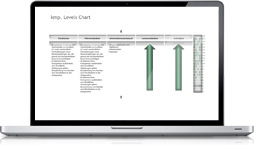The Common European Framework — CEF
The Common European Framework of Reference for Languages (CEF) consists of six levels of language proficiency (A1, A2, B1, B2, C1 and C2) describing the language level of non-native speakers. In 2001 CEF was officially accepted by the European Council as the official proficiency scale for learners and teachers of languages and has in the meantime been employed across the globe.
kmp. Level
Language proficiency
CEF Level
CEF-language proficiency level

181716

- Easily following discussions and presentations on a high linguistic level correctly identifying subtle differences in intonation and emphasis
- Negotiating on a high linguistic level adapting to the conversational style of your counterpart
- Easily understanding all types of written text
- Drafting or translating texts with general and specialised content employing a high stylistic level of language
C2

151413

- Following presentations with demanding content and level of language
- Delivering comprehensive, detailed presentations on subjects from a familiar business field
- Reading and understanding texts with specialised content
- Producing complex correspondence intended for specific addressees
C1

121110

- Following general and work-related business discussions and presentations without necessarily understanding each and every detail
- Describing intricate processes and situations
- Understanding the main content of comprehensive letters, emails, reports, contracts etc.
- Drafting formal work-related routine correspondence and texts with technical content
B2

987

- Following the basics of uncomplicated general or business-related discussions and presentations
- Participating in consultations and negotiations in the context of your specialised field of business
- Understanding the gist of work-related correspondence and literature of medium difficulty
- Drafting short, uncomplicated texts on familiar subjects
B1

654

- Following the basics of a short conversation between two native speakers (articulating clearly)
- Offering simple information on your field of work
- Understanding simple texts on familiar subjects
- Conveying uncomplicated information in writing (e.g. short and simple emails)
A2

321

- Understanding short, simple and clearly articulated statements
- Communicating basic personal and work-related information
- Understanding very simple correspondence (e.g. short confirmations)
- Completing simple forms with personal information, e.g. name, address
A1
